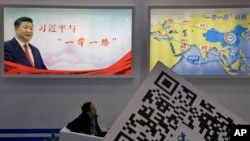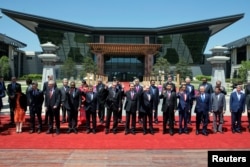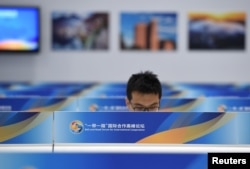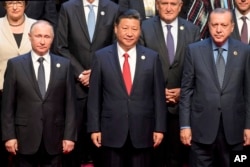As China hails the success of its first Belt and Road summit, major powers remain skeptical about the $1 trillion-dollar infrastructure and trade project. Analysts say while the ambitious plan has whet the appetite of developing nations, China missed an opportunity to get developed countries on board.
The fact that China could get the leaders of the World Bank, International Monetary Fund and the United Nations, along with 29 heads of state to sign a communique is a triumph for Beijing, said Ethan Cramer-Flood, associate director for the Conference Board’s China Center for Economics and Business.
By signing the document, they publicly endorsed Beijing’s vision. But that victory was largely symbolic, he said.
“Is it a signal of genuine economic cooperation or is it anything as significant, like a free trade negotiation where new policies are going to emerge because of this document. No, it certainly is not, it is a statement of intent,” Cramer-Flood said.
That intent was borne out by the use of bland phrases such as encouraging, enhancing and promoting, which showed up 16 times in the document. The document is loaded with references to U.N.-related issues, everything from poverty to sustainability and its wording was clearly “strained and stressed to be overwhelmingly inclusive” to get everyone on board, he added.
It also appears to have been prepared beforehand and participants had little opportunity to participate in its wording.
Unmet expectations
“This was an opportunity to create, well, on the one hand, the institutionalization of the initiative, which I think is very important, especially to the Western countries, you know. On the other hand, it was also an opportunity to create greater stakeholder buy-in,” said Jan Gaspers, a China analyst at the Mercator Institute for China Studies or MERICS.
The communique could have been an opportunity for Belt and Road countries to re-shape the initiate, but it was clear from the wording that did not happen, he said.
China also missed an opportunity when it failed to get support from developed countries to sign a crucial document for reducing trade barriers. Gaspers said those who refused to sign the document saw it as a step backwards.
“Basically, it would fall behind what was agreed within the framework of G-20 Summit last year on trade issues as it regards to transparency, reciprocity and so on,” Gaspers said.
Analysts say participants found common ground on issues such as finance, but the document on free trade was the one that faced the most headwinds.
“Certain western principles and values that some of the European countries wanted to insert were rejected by the Chinese side,” said the Conference Board’s Ethan Cramer-Flood. “And not just the Chinese side, I am hearing talk of Russia and Turkey as well,” “they weren’t able to get aligned on that wording.”
Wording and principles aside, it is mostly about getting a share of business.
Putting own interests first
Christopher Balding, a professor at Peking University’s HSBC Business School, said Beijing has made it exceedingly clear the Belt and Road will be a China focused project that will openly favor Chinese firms.
“I don’t think anyone [in developed countries] has any real expectations that their businesses will be able to compete for One Belt, One Road business in any real manner,” Balding said.
At the same time, developed countries are keenly aware the initiative is not only about public diplomacy, but also about domestic politics.
Later this year, China hosts a once in five-year leadership reshuffle, and raising the country’s international profile is crucial for President Xi Jinping as he works to consolidate power within the party.
“This is essentially what amounts to be an election year in China. This is something that a lot of people have overlooked, the importance of how this plays domestically in bolstering Xi Jinping and the [Communist] party’s image,” Balding said.
Gaspers said the meeting was also significant because of a political alignment of authoritarian forces that emerged, noting that it was no coincidence that Xi Jinping and the presidents of Russia and Turkey were seen standing so close to each other during the meetings.
“It shows a shift in terms of global and bilateral, and indeed multilateral alliances. That was confirmed at the summit and so optics were quite interesting,” he said.











